|
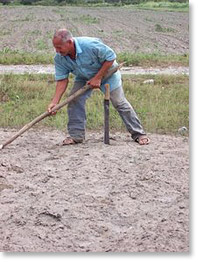 |
|
A member of the Pele el Ojo Cooperative farms using traditional methods. All photos by Christina Schiavoni.
|
|
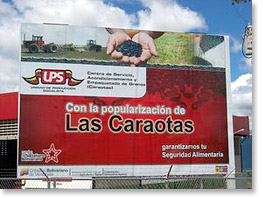 |
|
A government-sponsored plant for the processing of black beans, a staple food critical to Venezuela’s food security.
|
|
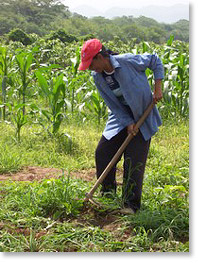 |
|
A member of the El Pereño cooperative in Yaracuy works the land.
|
|
 |
|
Farmer leader Irma Labaton de Viscaya is part of a seed-saving program in partnership with the government.
|
|
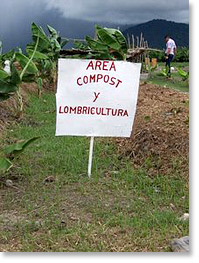 |
|
Composting and vermiculture (worm composting) area at the Aracal Cooperative.
|
|
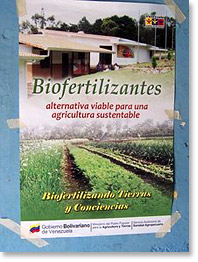 |
|
A poster promoting biological fertilizers at the Aracal Cooperative.
|
|
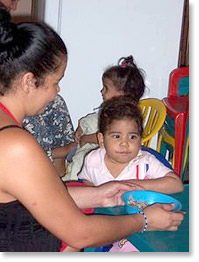 |
|
Lunchtime in a home for children sponsored by the city government of Tocuyito in the state of Carabobo.
|
|
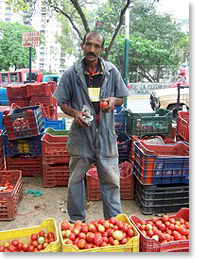 |
|
A farmer sells his produce at a community market in Caracas where farmers and consumers directly interact.
|
|
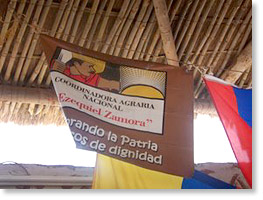 |
|
The banner of the Venezuelan farmers movement CANEZ and a Venezuelan flag on display at the Nyéléni food sovereignty forum in Mali.
|
A Process of Transformation
In the state of Yaracuy in the northwest of Venezuela, a small yellow, blue, and red flag flaps in the wind, rising above a dusty brown field dotted with tiny green sprouts of corn. Nearby sit a makeshift shelter, some agricultural equipment, and a banner on wooden poles. This is the newly formed Pele el Ojo ("Be Aware") Cooperative, and though it may not look like much, it represents a lot.
This is not the first time that the oldest members of the co-op have lived and farmed on this land. This was the site of a small farming community, which was violently occupied by a wealthy landholder during the Peréz Jiménez dictatorship in the 1950s. The landholder put up fences and declared control over everything inside – including the people. Some were massacred on the spot, others were coerced into slavery-like conditions, and eventually, all were displaced.
Today, some of the very people who were expelled from this land are part of the process of reclaiming it - together with their children and grandchildren. Now that they are back on their land, they are working to transform it based on a shared vision of what it can become. "We plan to create a diversified system with different types of fruit and vegetables to provide better food for the people in this area," explain several of the elders. "We will restore the soil, which has been poisoned over time, using ecological practices rather than toxic agrochemicals. We want to move away from a system that makes the Earth and people sick to one that is healthy for the people and the Earth."
The elders explain that reviving the land means reviving the agricultural practices that had been nearly lost along with it. They demonstrate the traditional way of planting corn, using machetes and wooden poles (four kernels are planted in each hole - "one for food; one for seed, one for birds, one for thieves"). Moments later, they show off a new tractor and other farm equipment that they have received from the government. Achieving their vision for this land will require a mix of traditional wisdom and new methods.
A Different Approach
The process of transformation of the Pele el Ojo Cooperative in many ways symbolizes Venezuela's path towards food sovereignty, as part of a broader struggle for national sovereignty and a transformed society. (1) Food sovereignty, in short, is the right of people to determine their own food and agricultural policies. It involves restoring control over food access and food production from large corporations and international financial institutions back to individual nations/tribes/peoples - and ultimately, to those who produce the food and those who eat it. It is a concept based on such principles as fairness, inclusion, transparency, sustainability, and self determination. (2)
I first became aware of Venezuela's efforts in the area of food sovereignty through my work on food and farm issues here in the U.S. Here, it often feels like we're putting out fires, constantly fighting to prevent further cuts to already under-funded programs such as food stamps for those at risk of hunger and credit for family farmers facing foreclosure. Advances have been made in certain areas, but sometimes I ponder what would be possible if we could fully direct our energy to real, system-wide change. When I first heard that this kind of change is underway in Venezuela, where food sovereignty is officially part of the national agenda, my interest was piqued.
Article 305 of the new Venezuelan constitution adopted in 1999 not only guarantees food security for all, but also guarantees food security through a stable, sustainable, and largely self-sufficient domestic food system. (3) Furthermore, it promotes sustainable agriculture and rural development. In essence, this article is guaranteeing food sovereignty. This sounded impressive in writing, but I wondered what it actually meant in practice.
I have now been to Venezuela on three separate occasions to learn what national support for food sovereignty looks like on the ground. Most recently, I was co-leader of a delegation of Rutgers University students interested in agrarian reform. Each visit has helped me piece together a picture of Venezuela's advances in food sovereignty, along with a better understanding of the challenges that remain - and each trip has also left me with new questions to try to answer the next time around. This is an initial attempt to share some observations and reflections based on what I have learned so far.
Land for Food, Food for People
"Agricultural land, first and foremost, is for producing food, food for people."
These words of lifelong farmer and political leader Braulio Alvarez are simple, yet carry years of intense struggle over the right to land for farming. If access to land is one of the most fundamental requirements for true food sovereignty, then therein lies one of Venezuela's greatest challenges. Disparities in land access and ownership have historically been so extreme that, according to a 1997 agricultural census, 5% of the largest land owners controlled 75% of the land, and 75% of the smallest landowners controlled only 6% of the land. (4) Much of this land in the hands of the large landholders, known as latifundio , sits idle or underused.
In 2001, the passage of the Law of the Land gave communities a legal framework for organizing themselves to settle and farm the idle lands. In the case of Pele el Ojo and many others, the lands had been illegally obtained by the landholders to begin with. There have been many obstacles to the implementation of the Law of the Land. More than 160 farmer leaders have been killed in acts of retaliation against the land reform process since the law's passage. Yet for the nearly 7,000 agricultural cooperatives created under this law, (5) the process of transformation is truly remarkable.
A powerful example is the Aracal Cooperative, formed in 2002 on newly recovered land totaling 1033 hectares (2553 acres). The land, originally owned by the state and illegally occupied by a single family, now belongs to the 150 different families who are members of the co-op. Together, they manage an integrated system of livestock, fruit trees, and mixed crops of vegetables, grains, and legumes. They use sustainable farming methods such as worm composting, biological pest control, and companion planting. They sell all of their crops directly through community markets, except for corn, which they sell to a state-run distributor. Milk currently goes to a cheese processor, but they have plans to open their own cheese processing facility. They have already built a bean and cereal packaging plant on the premises. They have also just inaugurated a "biolab" for the production of organic fertilizers and natural pesticides to support their sustainable farming practices.
Aracal was granted a title to the land in 2004, and the title belongs to the entire community, rather than to any one individual. In order to retain the title, the community must ensure that the land is producing food for people. Not only are community members granted secure land access, they are charged with being the stewards of the land, ensuring its productivity in order to contribute to food sovereignty.
"Many of the people now farming in cooperatives used to be day laborers, but they have farming in their blood," states Aracal president Omar Oviedo. "The co-op provides a better life for these families who have lived under difficult conditions."
Tools for Success
While securing land is an important measure in and of itself, it takes more than land to sustain a thriving farm community. Farmers need access to credit, training, seeds, and equipment, as well as basic services for themselves and their families.
In the past, small-scale farmers were regularly denied access to credit or charged exploitative interest rates. To address this issue, the government has recently created the Agricultural Bank, which grants low-interest loans to cooperatives through a participatory process. Now, rather than being denied credit, farmers are the ones making the decisions. "In the past, agricultural planning was top-down and imposed upon communities. Now it takes place through a much more participatory process," explains Agricultural Bank president Eduardo Escobar. "This bank is a communal space for interactions among members of farming communities. They determine credit needs based on social needs. Credit is not just about money; there's also an organizing component. All of the offices here are spaces for community processes, discussions, and consensus-building."
Cooperatives are also receiving necessary inputs and equipment, along with training and technical assistance. Through the Campo Adentro ("Into the Countryside") program, for instance, 2,000 Cuban agronomists specializing in organic agriculture are partnered with Venezuelan cooperatives to provide consultation and training. This is carried out along with local farmer-to-farmer programs that facilitate exchange of knowledge and skills. Additional government-sponsored programs are addressing housing, food access, education, medical care, child care, phone and internet access, and access to community media outlets.
The next major hurdle is access to stable markets and assurance of adequate income for farmers. This is being addressed through a variety of measures, including price stabilization, and direct support for staple crops; the formation of state-sponsored food processing centers; and the formation of a network of community farmers' markets throughout the country.
Working with Nature
Not only are Venezuelans working to increase domestic food production; they are looking at how food is being produced. In conversations with Miguel Angel Nuñez of the Institute for the Production and Research of Tropical Agriculture (IPIAT), he describes an agroecological approach to food production as critical to achieving true food sovereignty. Agroecology essentially means farming with nature rather than against it - building up soil as the basis for productivity; working in sync with the cycles of nature; using natural inputs; etc.
Miguel Angel makes a number of arguments as to why this approach is so important for Venezuela. (6) First, it provides a viable alternative to the industrial model of agriculture imposed by the Green Revolution, which was designed as a one-size-fits-all formula that never considered the unique conditions of the tropics. When applied in tropical conditions, the industrial model degrades the soil; creates extra waste while requiring extra cost; and fails to reach the same levels of productivity as more appropriate, locally-adapted systems (e.g., agroforestry and mixed cropping). Additionally, the industrial model of agriculture, by its very definition, requires expensive external inputs, such as specially bred seeds, and synthetic fertilizer and pesticides. Dependence on such inputs is being as in direct conflict with the concept of food sovereignty. Can a nation have true control of its food system while depending upon seeds from multinational agribusinesses?
An agroecological approach to food sovereignty requires looking not outside, but within communities, for traditional crop varieties and growing techniques adapted to local microclimates and local cultures. This approach corresponds with the concept of "endogenous development," or "development from within," promoted as a core component of Venezuela's political process. Adopting this approach means seeking out and valuing the wisdom of typically marginalized populations, such as women, indigenous people, and afro-descendents.
Last year, the Venezuelan government, in partnership with the Landless Workers Movement of Brazil (MST) and the Via Campesina global peasant network, gave this knowledge a new level of recognition and support. They created the Paulo Freire Latin American Agroecological Institute for Campesino, Indigenous, and Afro-Descendent Studies in the state Barinas, Venezuela. This unique school, which also sits on recovered latifundio land, is currently attended by a diverse group of 160 students from 13 countries throughout Latin America. The students each represent social movements from their home countries and will use their studies to directly benefit society back home.
The creation of this special school, founded by and for social movements, speaks to the important role that social movements play in shaping the national food sovereignty agenda. As Miguel Angel explains, while there are still differing ideas on what path Venezuela's agricultural sector should take, the government has consistently showed a willingness to learn from social movements. It is this very type of dialogue that led Venezuela to declare a national moratorium on genetically modified crops. This has been followed up by national efforts to preserve and multiply traditional seed varieties, both through farmer-led initiatives and through the establishment of national genetic research centers, such as the new Florentine Genetic Center in the state of Barinas (a partner institution to the Agroecological Institute).
Communities Feeding Themselves
The efforts to bolster domestic food production in Venezuela are being met with efforts to increase the ability of communities to feed themselves. There are over 6,000 casas de alimentación, or feeding houses, around the country -- similar to U.S. soup kitchens, but with a much broader mission. Casas provide nutritious food to those who need it most (pregnant women, children, the elderly, etc.), but are also meant to serve as hubs of community gathering and organizing. These programs are primarily based out of people's homes, and many were started by volunteers, purely to meet needs of their communities. They are now run through a remarkable grassroots/government partnership: the government provides food and kitchen equipment, and members of the community prepare the food and keep the sites running.
As the program has become established, those who run the casas now receive stipends, increasing community self-sufficiency. A woman who runs a feeding program directly out of her living room in the El Valle neighborhood of Caracas is clear about her priorities: "This is my job, but I don't do it for the money. This is my contribution to the process [of broader social change]." Additionally, the government promotes Venezuelan agriculture in the food that it provides to the casas, with the goal of eventually supplying 100% Venezuelan-grown food.
Along with providing for those most in need, there is an emphasis on universal access to affordable high-quality food. In 2002, the government started Mercal , a national network of subsidized food markets. The markets were created after a group opposing the government attempted to bring the national economy to a standstill by halting oil production and shutting down major industries. Major food distributors withheld food supplies and corporate-run supermarkets closed. This drove home the implications of Venezuela importing over 70% of its food, primarily from large corporations.
In response, the government stepped up its food sovereignty efforts by bolstering Venezuelan agriculture for domestic consumption and creating food storage facilities and the Mercal system to serve the people. Food in each of the over 15,000 Mercal outlets around the country is sold at 20-50% off regular prices, and the stores are open to anyone of any income level. Markets range in size from mobile Mercales and tiny Mercalitos to large-scale markets, some of which now include pharmacies to increase access to affordable medical supplies. Packaging for staples such as corn meal and rice are decorated with educational messages and excerpts from the Venezuelan constitution.
Connecting the Parts - a Major Challenge
While Venezuela has made strides in recent years in both food production and food access, a major challenge still remains in connecting these efforts. The food system's weakest link is the infrastructure to get food from field to plate. According to the Agricultural Ministry, an explanation lies in the intentional consolidation and dismantling of this infrastructure in past years.
Like the U.S. auto industry's dismantling of the light rail system in the 1900s, (7) Venezuela's system of silos and other food storage facilities was bought up by businesses who knew that there were greater profits to be made in exporting and importing food. This enabled a certain few to make money both through the exportation of Venezuelan raw agricultural products and the importation of processed goods for consumption. In certain instances, the very same products were exported, processed, and then brought back into the country, making big profits for the middlemen with no benefits to the farmer or consumer.
Despite recent government efforts to put the country's food system back into the hands of the people, many of the same intermediaries still control the flow of food, even much that goes to Mercal. Although Mercal has made some advances towards its goal of sourcing domestically grown products, this helps to explain why the process has been so slow.
In an attempt to get around the intermediaries and foster direct producer-consumer relationships, the Agricultural Ministry has set up a system of community-based markets in which farmers sell their products directly to consumers. This growing system of "popular markets" is an effective way of providing direct markets for farmers and access to low-cost, fresh, local food for consumers. However, it should ideally be a complement to the Mercal system, and not a substitution for it.
A Vision of Food Sovereignty
The problems of Venezuela's food system have not changed overnight. Yet the advances towards food sovereignty made in a relatively short time point to an important process underway - one that is worth paying attention to.
The belief that this process has major implications not only for the Americas but the rest of the world was reflected in the invitation of Venezuelan President Hugo Chavez to speak at the first global food sovereignty forum, Nyéléni 2007, held this past February in Mali. Although Chavez couldn't be there in person, he addressed the crowd via video, (8) giving an overview of recent developments in Venezuela and describing attempts to foster international relationships that respect each nation's right to food sovereignty. He described the recent opening of a tractor factory in Venezuela that will not only provide tractors to domestic farmers, but also to farmers in neighboring countries, such as Bolivia. At the end of the address, an Indian farmer, nearly brought to tears, expressed the hope this brings him as he struggles for food sovereignty in his own country, where thousands of farmers, abandoned by both their government and society at large, have committed suicide in recent years.
Despite the many challenges that remain to achieving food sovereignty in Venezuela, there is a clear commitment on the part of the people and the government to making it happen, and this commitment is informing and inspiring struggles for food sovereignty throughout the world.
About the author: Christina Schiavoni is International Coordinator at WHY (World Hunger Year). Based in New York, WHY is a leading advocate for innovative, community-based solutions to hunger and poverty.
Footnotes
1. Venezuela's food sovereignty initiatives cannot be examined in isolation, as they are part and parcel of the country's broader political and social change. Venezuela's political process is known as the Bolivarian Revolution, named for Simon Bolivar. Bolivar led struggles for independence throughout Latin America in the early 19th century, and has come to represent the popular struggle for Latin American self-determination and liberation from imperialist and colonialist forces. These ideals figure heavily within the Bolivarian Revolution and are important in the struggle for food sovereignty. A collection of articles in English on the Bolivarian Revolution is available at www.venezuelanalysis.com.
2. The term food sovereignty was originated by the Via Campesina global peasant network, which continues to lead this movement internationally.
3. Embassy of the Bolivarian Republic of Venezuela in the United States , Article VI of the Venezuelan Constitution.
4. Gregory Wilpert, " Land for People not for Profit in Venezuela ," Venezuelanalysis.com, 23 August 2005.
5. Miguel Angel Nuñez, “How Far is the Venezuelan Revolution Advancing?,” In Motion Magazine, 18 February 2007.
6. For a collection of articles by Miguel Angel Nuñez on agroecology and food sovereignty in Venezuela, see www.inmotionmagazine.com
7. Eric Schlosser, Fast Food Nation: The Dark Side of the All-American Meal (New York: HarperCollins, 2002)
8. To watch, go to Chavez video.
Published in In Motion Magazine December 16, 2007
|











